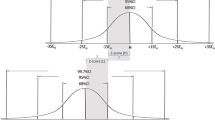Abstract
Two studies were conducted to examine the effect of grade inflation on the piling up of grades in fewer grade categories and on the reliability of grade point averages (GPAs). In all comparisons, grades were more bunched after grade inflation, which in turn, was associated with only slight, nonsignificant decreases in GPA reliability. As expected, grades were more bunched when the traditional 5-point letter scale was used than when plus and minus grades were also allowed. In the latter case as well, grade inflation seemed to have had very little effect on the reliability of GPAs. GPA reliability began to suffer, however, for graduate programs in which almost all grades were placed into just two categories, A and B.
Similar content being viewed by others
References
Bejar, I. I., and Blew, E. O. Grade inflation and the validity of the Scholastic Aptitude Test.American Educational Research Journal 1981,18 143–156.
Bendig, A. W. Reliability and the number of rating scale categories.Journal of Applied Psychology 1954,38 38–40.
Ebel, R. L. The relation of scale fineness to grade accuracy.Journal of Educational Measurement 1969,6 217–221.
Educational Testing Service. Test use and validity: a response to charges in the Nader/Nairn report on ETS. Princeton: Educational Testing Service, February 1980.
Gulliksen, H.Theory of Mental Tests. New York: Wiley, 1950.
Juola, A. E. Grade inflation — 1979. Is it over? Paper presented at the annual meeting of the National Council on Measurement in Education, Boston, April 1980.
Komorita, S. S., and Graham, W. K. Number of scale points and the reliability of scales.Educational and Psychological Measurement 1965,4 987–995.
Masters, J. R. The relationship between number of response categories and reliability of Likert type questionnaires.Journal of Educational Measurement 1974,11 49–53.
Matell, M. S., and Jacoby, J. Is there an optimal number of alternatives for Like scale items? Study I: Reliability and validity.Educational and Psychological Measurement 1971,31 657–674.
Senders, V. L.Measurement and Statistics. New York: Oxford University Press, 1958.
Singleton, R., and Smith, E. R. Does grade inflation decrease the reliability of grades?Journal of Educational Measurement 1978,15 37–41.
Stanley, J. C. Reliability. In R. L. Thorndike (Ed.),Educational Measurement (2nd ed.). Washington: American Council on Education, 1971.
Symonds, P. M. On the loss of reliability in ratings due to coarseness of the scale.Journal of Experimental Psychology 1924,7 456–461.
Author information
Authors and Affiliations
Rights and permissions
About this article
Cite this article
Millman, J., Slovacek, S.P., Kulick, E. et al. Does grade inflation affect the reliability of grades?. Res High Educ 19, 423–429 (1983). https://doi.org/10.1007/BF01418444
Received:
Issue Date:
DOI: https://doi.org/10.1007/BF01418444




